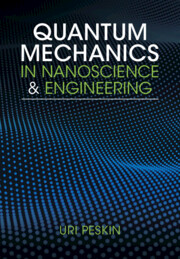Book contents
- Quantum Mechanics in Nanoscience and Engineering
- Additional material
- Quantum Mechanics in Nanoscience and Engineering
- Copyright page
- Contents
- Preface: Who Can Benefit from Reading This Book?
- 1 Motivation
- 2 The State of a System
- 3 Observables and Operators
- 4 The Schrödinger Equation
- 5 Energy Quantization
- 6 Wave Function Penetration, Tunneling, and Quantum Wells
- 7 The Continuous Spectrum and Scattering States
- 8 Mechanical Vibrations and the Harmonic Oscillator Model
- 9 Two-Body Rotation and Angular Momentum
- 10 The Hydrogen-Like Atom
- 11 The Postulates of Quantum Mechanics
- 12 Approximation Methods
- 13 Many-Electron Systems
- 14 Many-Atom Systems
- 15 Quantum Dynamics
- 16 Incoherent States
- 17 Quantum Rate Processes
- 18 Thermal Rates in a Bosonic Environment
- 19 Open Quantum Systems
- 20 Open Many-Fermion Systems
- Index
- References
19 - Open Quantum Systems
Published online by Cambridge University Press: 11 May 2023
- Quantum Mechanics in Nanoscience and Engineering
- Additional material
- Quantum Mechanics in Nanoscience and Engineering
- Copyright page
- Contents
- Preface: Who Can Benefit from Reading This Book?
- 1 Motivation
- 2 The State of a System
- 3 Observables and Operators
- 4 The Schrödinger Equation
- 5 Energy Quantization
- 6 Wave Function Penetration, Tunneling, and Quantum Wells
- 7 The Continuous Spectrum and Scattering States
- 8 Mechanical Vibrations and the Harmonic Oscillator Model
- 9 Two-Body Rotation and Angular Momentum
- 10 The Hydrogen-Like Atom
- 11 The Postulates of Quantum Mechanics
- 12 Approximation Methods
- 13 Many-Electron Systems
- 14 Many-Atom Systems
- 15 Quantum Dynamics
- 16 Incoherent States
- 17 Quantum Rate Processes
- 18 Thermal Rates in a Bosonic Environment
- 19 Open Quantum Systems
- 20 Open Many-Fermion Systems
- Index
- References
Summary
Typically, we are interested in a small system (a few particles, or some region in space), entangled with its surroundings. Exact equations (Dyson or Nakajima–Zwanzig) for the reduced system dynamics are readily derived using suitable projection operators. They are rarely solvable, however, since full account is taken for mutual influences between the system and its environment. Nevertheless, for weak mutual coupling, environment-induced dynamics in the (small) system can be much slower than system-induced dynamics in the (large) environment. This justifies the Born–Markov approximation, leading to closed equations for the system. In Hilbert space, we demonstrate the emergence of irreversible dynamics and exponential decay for pure sates. In Liouville space, we derive the Redfield equation. Invoking the secular (or, rotating-wave) approximation, we derive Pauli’s master equations, which properly account for relaxation to equilibrium. Rates of spontaneous emission, coherence transfer (Bloch equations), and pure dephasing are derived and analyzed for a dissipative qubit.
Keywords
- Type
- Chapter
- Information
- Quantum Mechanics in Nanoscience and Engineering , pp. 391 - 430Publisher: Cambridge University PressPrint publication year: 2023

